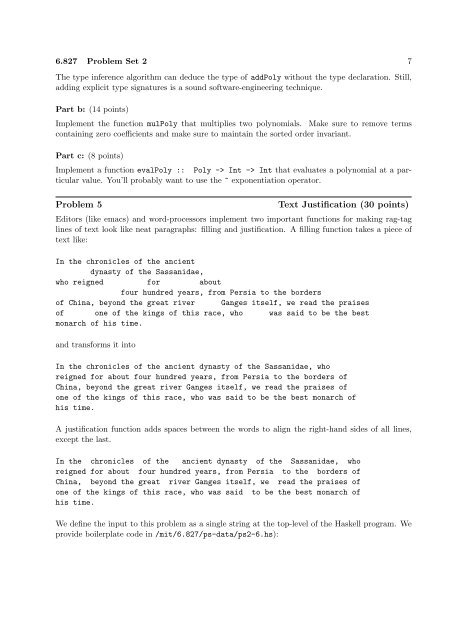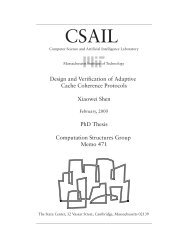Problem Set 2 - MIT
Problem Set 2 - MIT
Problem Set 2 - MIT
You also want an ePaper? Increase the reach of your titles
YUMPU automatically turns print PDFs into web optimized ePapers that Google loves.
6.827 <strong>Problem</strong> <strong>Set</strong> 2 7<br />
The type inference algorithm can deduce the type of addPoly without the type declaration. Still,<br />
adding explicit type signatures is a sound software-engineering technique.<br />
Part b: (14 points)<br />
Implement the function mulPoly that multiplies two polynomials. Make sure to remove terms<br />
containing zero coefficients and make sure to maintain the sorted order invariant.<br />
Part c: (8 points)<br />
Implement a function evalPoly :: Poly -> Int -> Int that evaluates a polynomial at a particular<br />
value. You’ll probably want to use the ^ exponentiation operator.<br />
<strong>Problem</strong> 5 Text Justification (30 points)<br />
Editors (like emacs) and word-processors implement two important functions for making rag-tag<br />
lines of text look like neat paragraphs: filling and justification. A filling function takes a piece of<br />
text like:<br />
In the chronicles of the ancient<br />
dynasty of the Sassanidae,<br />
who reigned for about<br />
four hundred years, from Persia to the borders<br />
of China, beyond the great river Ganges itself, we read the praises<br />
of one of the kings of this race, who was said to be the best<br />
monarch of his time.<br />
and transforms it into<br />
In the chronicles of the ancient dynasty of the Sassanidae, who<br />
reigned for about four hundred years, from Persia to the borders of<br />
China, beyond the great river Ganges itself, we read the praises of<br />
one of the kings of this race, who was said to be the best monarch of<br />
his time.<br />
A justification function adds spaces between the words to align the right-hand sides of all lines,<br />
except the last.<br />
In the chronicles of the ancient dynasty of the Sassanidae, who<br />
reigned for about four hundred years, from Persia to the borders of<br />
China, beyond the great river Ganges itself, we read the praises of<br />
one of the kings of this race, who was said to be the best monarch of<br />
his time.<br />
We define the input to this problem as a single string at the top-level of the Haskell program. We<br />
provide boilerplate code in /mit/6.827/ps-data/ps2-6.hs):
















